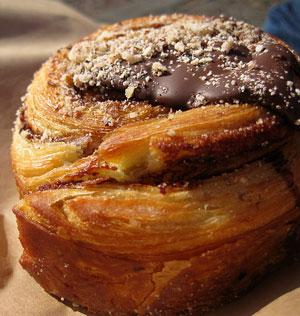
Dear Sticky Wicket,
Why do we refer to most pastries collectively as Danishes? Did pastries, or a recognizable type of pastry, originate with the Danes?
~ Cindy Ferraino
Walk into any morning business meet and greet, or a comfy lounge area in a hotel, or conference center, and you will find a delightful and enticing display of portable treats to keep you moving and grooving until lunchtime. We refer to "Danishes or pastries," as portable treats because they often fall into the top feature section of a light breakfast starter menu. Both names refer to a small doughy texture that we roll and shape, and fill with a variety of toppings.
According to George Faust, Chef/Owner of Cibo Grill, LLC in Gloucester County, New Jersey, Danish pastries are a very popular choice for customers-especially doctor’s offices and other work places. “Pastries are great because they don’t need a lot of work and attention once they are made. They hold well sitting out on the counter and can be enjoyed at breakfast, lunch, dinner, or even as a snack," Faust said.
How did these small delicious snacks become so popular on American buffet and kitchen tables?
A traditional Danish got its humble start in Denmark around the 1800’s. Danish bakers created these delectable treats for people to enjoy something light with their morning cup of joe or tea before they started their daily duties routines. The original ingredients of a Danish consisted of the binders yeast and flour, milk, fresh farm eggs, and Southern gal, Paula Den’s favorite, butter!
While the demand of satisfying a hungry crowd of pastry lovers increased, so did the creative minds of the bakers as they began to add other ingredients to make their own signature pastries. The “Kringle,” is like a Danish, but shaped liked an American pretzel. Bakers additionally experimented with fruits and nuts, as well as sweets like chocolate and vanilla.
During the late 1800s to early 1900s, Danish immigrants introduced their doughy treasures to the American population, and the Danish treat quickly took over the streets and kitchens of American homes, including one famous home, the White House in Washington, D.C.
According to food critic Barry Popik, barrypopik.com, Danish immigrant, L.C. Klitteng made Danish pastries for the inaugural party of President Woodrow Wilson, and his research further uncovered that Klitteng opened a Danish culinary institute on Fifth Avenue in New York City. “The Danish pastry reached popularity in New York City," Popik said in an email response to our USARiseUp.com inquiry.
In addition, Popik stumbled upon old magazines that held advertisements for Danish pastries from immigrants trying to sell their native products. He noted there are differences between a pastry and a Danish. “Although there are many variations of what people call the “Danish pastry,” the authentic Danish pastry, such as most people are able to tell the difference between a Danish pastry and a breakfast croissant at breakfast.
The next time you wander into a Starbucks, or the lobby of a hotel in any city in the United States, and decide to sample something to eat, remember that the Danish or pastry you are about to enjoy is part of the melting pot fabric that has shaped the world we live in today.
